Laila Taha1, Siham Bakhit2, Marwa Elgizouli3, Dalia Sibirah3
1Biochemistry Department, Central Laboratories, Alzaeim Alazhari University (AAU), Khartoum North, Sudan
2Biochemistry Department, Faculty of Medicine, Alzaeim Alazhari University (AAU), Khartoum North, Sudan
3Medical Resident at King Khalid Hospital, Majmaa, KSA
Correspondence to: Laila Taha, Biochemistry Department, Central Laboratories, Alzaeim Alazhari University (AAU), Khartoum North, Sudan.
| Email: |  |
Copyright © 2016 Scientific & Academic Publishing. All Rights Reserved.
This work is licensed under the Creative Commons Attribution International License (CC BY).
http://creativecommons.org/licenses/by/4.0/

Abstract
Objective: This study aimed to compare the antidiabetic effects of some Sudanese plants used traditionally by diabetic patients in Khartoum state, Sudan. The problem of this study lied under that Sudanese diabetic patients using some Sudanese medicinal plants without knowing their pharmaceutical effect and their dose. Materials & Methods: The essays of the present study were conducted on albino rats which obtained from the faculty of pharmacy, University of Khartoum, Sudan. Forty two albino rats of either sex weighing (135-250g) and aged two months were used. Six animals were serve as control (group 1), thirty six animals treated groups (2, 3, 4, 5, 6 and 7) (N=6). Dexamethasone (10mg/kg .b.w) for 10 days is used to induce hyperglycemia and Hyperlipidemia after eighteen hours fasting. Groups (2, 3 and 4) were administered with three different doses of Trigonella foenum graecum (Fenugreek) aqueous extract (200, 400 and 800mg/kg-b.w) respectively, groups (5, 6 and 7) were administered with three different doses of Solenstomma Hargel aqueous extract (200, 400 and 800mg/kg-b.w) respectively. Blood specimens were collected from each group after2 and 4 hours, serum levels of blood glucose, lipid profile and α-amylase concentrations were estimated. The plants used in this experiment clearly demonstrate the non-toxic nature and safety profile. The combined history human use of these plants and the data from the current study support the safe use of these plants. Result: The results obtained from this study showed that Trigonella foenum graecum (Fenugreek) and Solenstomma Hargel aqueous extract had significant hypoglycemic effect more over they have reducing effect on lipid profile. Solenstomma Hargel aqueous extract had un expected increase in α-amylase level at high concentration compared to Trigonella foenum graecum (Fenugreek) which have decreasing effect. Conclusion: It can be concluded from this study that Trigonella foenum graecum (Fenugreek) had more hypoglycemic effect at small dose (200mglkg.-b.w) when compared with Solenstomma Hargel aqueous extract. The two extracts had significant hypoglycemic effect more over with no side effect.
Keywords:
α-amylase, Diabetes mellitus, Dexamethasone, Cholesterol, Solenstomma Hargel, Trigonella foenum graecum (Fenugreek), Triglycerides
Cite this paper: Laila Taha, Siham Bakhit, Marwa Elgizouli, Dalia Sibirah, The Effect of Trigonella Foenum Graecum (Fenugreek) on the Blood Glucose, Lipid Profile and α-Amylase for Diabetic Albino Rats Compared with Solenstomma Hargel, International Journal of Diabetes Research, Vol. 5 No. 6, 2016, pp. 135-140. doi: 10.5923/j.diabetes.20160506.03.
1. Introduction
The term diabetes mellitus describes as metabolic disorder of multiple etiologies characterized by chronic hyperglycemia with disturbances of carbohydrates, fats and protein metabolism resulting from defects in insulin secretion, or insulin resistance or both [1]. Diabetes mellitus is a leading cause of death and disability worldwide [2].The term medicinal plant is used to determine the plant or plant products used by human beings in the protection against, or treatment of illness [3]. It occurs throughout the world, but is more common (specially type 2) in the more developed countries. The greatest increase in prevalence is, however, expected to occur in Asia and Africa [3]. Rates of diabetes have increased markedly over the last 50 years in parallel with obesity [4]. Despite recent advances in care and management, diabetes mellitus continues to be an important public health concern, causing substantial morbidity and mortality and long-term complications [5]. In recent years, much emphasis has been placed dietary habits as being significant factors affecting human health [6]. A number of medicinal/culinary herbs have been reported to yield hypoglycemic effects in patients with diabetes. Examples of these include bitter melon, Gymea, Korean ginseng, onions, garlic, flaxseed meal, and specific nutrients including α- lipoic acid, biotin, carnitine, vanadium, chromium, magnesium, zinc, and vitamins B3, E, and K [7]. Sudanese patients used some medicinal plants as treatment of diabetes such as Trigonella foenum graecum (fenugreek), Solenstomma Hargel, lupine turmos and Ilium sativum (garlic).Trigonella foenum graecum (Fenugreek) L species of Trigonella genus, Leguminosae family, Fables order of kingdom Plantae. Fenugreek is extensively grown in the tropical and subtropical regions of India. Fenugreek is known locally by its Arabic name “Helba" or in English as fenugreek [8]. Fenugreek known in Morocco as “Helba” is used in folk medicine for its anti-ulcer, anti-inflammatory, cicatrizing activities and to treat various pain-related physiological conditions [9]. The applications of Fenugreek were documented in ancient Egypt, where it was used in incense and to embalm mummies [10]. Fenugreek seeds are a rich source of fiber and protein, bulk of the seeds is dietary fiber (50%) and protein (30%) both of which have no taste or flavor. fenugreek contains approximately 4 to 8% saponins and about 1% alkaloid. Bitterness is mainly due to the oil, steroidal saponins and alkaloids [11]. In vitro and in vivo clinical studies have discovered the hypoglycemic action of fenugreek among the herbs for diabetes [12].Solenstomma Hargel or argel (Del.) Hayn plantae kingdom, Gentanales Order, Apocynaceae family, Solenoslemma Genus and S. Hargel Species. It is a desert plant which widely distributed in Egypt, Libya, Chad, Algeria, Saudi Arabia, Palestine, Central and Northern part of the Sudan however, among these above mentioned countries, Sudan is regarded as the richest source of the Hargel plant which found between Barbar and Abu Hamad [13]. The plant leaves are used in folk medicine as antispasmodic, carminative, antiseptic and diuretic and for the treatment of gastrointestinal disturbances, hepatic injury, renal calculi and dysentery due to the presence of flavonoids, tannins, sterols, monoterpenes, triterpenes and pregnane glycosides [14].
2. Materials and Methods
2.1. Study Area
Medicinal and Aromatic Plants Research Institute, National centre for Research, Khartoum, Sudan.
2.2. Plant Materials
Plants selected according to questionnaire which resulted (44.6%) of Sudanese diabetic patients used Trigonella foenum graecum (Fenugreek) and (57.1%) used Solenstomma Hargel, the plants parts used in this study were: Trigonella foenum graecum (Fenugreek) seeds, and Solenstomma Hargel leaves and park. The plants were collected from local market at Omdurman, purified, ground to powder using mechanical grinder and preserved in air tight container and kept separately in clean dry bottles [16].
2.3. Preparation of Aqueous Extraction
Extraction of each plant was carried out according to the method described by [15] 300g of each plant sample was soaked in 2000 ml of hot distilled water, and left till cooled down with continuous stirring at room temperature. Extract was then filtered and freeze in a deep. Freezed extract was dried using Freeze drying apparatus till powdered extract obtain. The powder residue was re-dissolved in distilled water before experimentation.
2.4. Animals and Induction of Diabetes
Forty two Wister albino rats of either sex weighing (135-250g) and aged two months were used in this experiment. Rats used were kept on a fixed diet so as to stabilize the fasting plasma glucose level which was fixed at (70-110mg/dl) level for 3 days, as an adaptation period. tested groups (2, 3, 4, 5, 6 and 7) were fasting for 18 hours then loaded with Dexamethasone (10mg/kg .b.w) for 10 days to induce hyperglycemia and Hyperlipidemia. The fasting blood glucose (FBG) was measured. The rats with a FBG level higher than 120mg/dl were diagnosed as diabetic and included in the study. Treated groups (2, 3, 4, 5, 6, and 7) were administered orally with different doses of tested plants aqueous extracts.
2.5. Treatment Experiment
In this experiment forty two albino rats were used, animals were allotted randomly into seven groups (N= 6). Group (1) was administered orally with distilled water and normal diet as control, treated groups were loaded with Dexamethasone (10mg/kg .b.w) for 10 days after eighteen hours fasting, to induce diabetes, blood samples had been taken to investigate glucose concentration, animals with blood glucose ≥120mg/dl were considered as diabetic and included in this experiment. Groups (2, 3 and 4) were administered orally with (200,400 and 800mg/kg-b.w) Trigonella foenum graecum (fenugreek) aqueous extract, groups (5, 6 and 7) were administered with (200, 400 and 800mg/kg-body weight) Solenstomma Hargel aqueous extract respectively, blood samples were collected to investigate blood glucose, cholesterol, triglycerides and α-amylase concentration after 2 and 4 hours [17].Statistical analysis: Statistical Package for Social Science (SPSS) computer software was used for data analysis. Independent T-test was used [18], Significance levels were set at (p≤ 0.05).
3. Results
Table (1) shows blood glucose of group (2) which was administer with (200mg/kg- body weight) Trigonella foenum graecum (Fenugreek) aqueous extract after 2 and 4hours was (101mg/l and 108mg/l) respectively, there was no significant difference with control group. Group (5) which was administered with (200mg/kg-body weight) Solenstomma Hargel aqueous extract after 2 and 4hours was (170mg/l and 131mg/l) respectively, there was a significant difference with control group (P≤0.05).Table (1). The effect of (200mg/kg-body weight) of Trigonella foenum graecum (Fenugreek) and Solenstomma Hargel aqueous extract on blood glucose to induced diabetic albino rats
 |
| |
|
Table (2) shows blood glucose of group (3) which was administered with (400mg/kg- body weight) Trigonella foenum graecum (Fenugreek) aqueous extract after 2hours and 4hours was (131mg/l and 108mg/l) respectively, there was no significant difference with control group after 4hours.Table (2). The effect of (400mg/kg-body weight) of Trigonella foenum graecum (Fenugreek) and Solenoslemma Hargel aqueous extract on blood glucose to induced diabetic albino rats
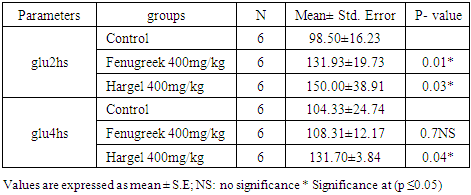 |
| |
|
Group (6) which was administered with (400mg/kg-body weight) Solenstomma Hargel aqueous extract after 2hours and 4hours was (150mg/l and 131mg/l) respectively, there was a significant difference with control group (P≤0.05).Table (3) shows blood glucose of group (4) which was administered with (800mg/kg- body weight) Trigonella foenum graecum (Fenugreek) aqueous extract after 2hours and 4hours was (131mg/l and 127mg/l) respectively, there was no significant difference with control group after 4hours.Table (3). The effect of (800mg/kg-body weight) of Trigonella foenum graecum (Fenugreek) and Solenstomma Hargel aqueous extract on blood glucose to induced diabetic albino rats
 |
| |
|
Blood glucose of group (7) which was administered with (800mg/kg-body weight) Solenstomma Hargel aqueous extract after 2hours and 4hours was (115mg/l and 125mg/l) respectively, there was no significant difference with control group (P≤0.05) after 4hours.Table (4) shows blood cholesterol of group (2) which was administered with (200mg/kg- body weight) Trigonella foenum graecum (Fenugreek) aqueous extract after 2 and 4hours was (39mg/l and 36 mg/l) respectively, there was no significant difference with control group.Table (4). The effect of (200mg/kg-body weight) of Trigonella foenum graecum (Fenugreek) and Solenoslemma Hargel aqueous extract on Cholesterol and Triglycerides concentrations to induced diabetic albino rats
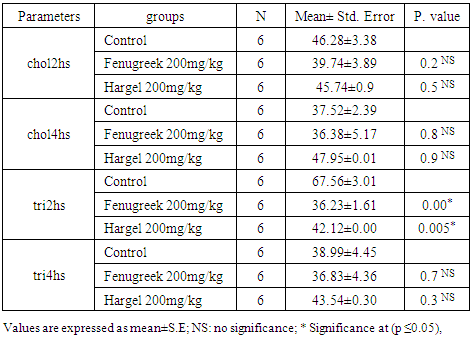 |
| |
|
Group (5) which was administered with (200mg/kg-body weight) Solenstomma Hargel aqueous extract after 2hours and 4hours was (45.47mg/l and 47.9 mg/l) respectively, there was no significant difference with control group (P≤0.05). Concerning group (2) blood triglycerides concentration was (36.2mg/l and 36.8mg/l) after 2 and 4hoursrespectively, there were no significant difference with control group after 4hours. Group (5) triglycerides concentration was (42.1 and 43.5) after 2 and 4 hours respectively, there was no significant difference with control group after 4hours.Table (5) shows blood cholesterol of group (3) which was administered with (400mg/kg- body weight) Trigonella foenum graecum (Fenugreek) aqueous extract after 2 and 4hours was (46mg/l and 36 mg/l) respectively, there was no significant difference with control group.Table (5). The effect of (400mg/kg-body weight) of Trigonella foenum graecum (Fenugreek) and Solenstomma Hargel aqueous extract on Cholesterol and Triglycerides concentrations to induced diabetic albino rats
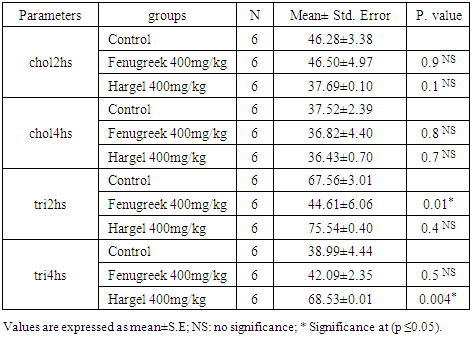 |
| |
|
Blood cholesterol of group (6) which was administered with (400mg/kg-body weight) Solenstomma Hargel aqueous extract after 2 and 4hours was (37.6 mg/l and 36.4 mg/l) respectively, there was no significant difference with control group. Concerning group (3) blood triglycerides concentration was (44.6mg/l and 42.1mg/l) after 2 and 4hours respectively, there was no significant difference with control group after 4hours. Group (6) triglycerides concentration was (75.5 and 68.5) after 2 and 4 hours respectively, there was no significant difference with control group after 2hours.Table (6) shows blood cholesterol of group (4) which was administered with (800mg/kg- body weight) Trigonella foenum graecum (Fenugreek) aqueous extract after 2 4hours was (55.mg/l and 43.7 mg/l) respectively, there was no significant difference with control group.Table (6). The effect of (800mg/kg-body weight) of Trigonella foenum graecum (Fenugreek) and Solenstomma Hargel aqueous extract on Cholesterol and Triglycerides concentrations to induced diabetic albino rats
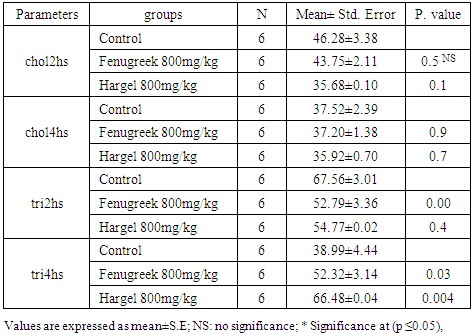 |
| |
|
Blood cholesterol of group (7) which was administered with (800mg/kg-body weight) Solenstomma Hargel aqueous extract after 2 and 4hours was (37.6 mg/l and 36.4 mg/l) respectively, there was no significant difference with control group. Concerning group (3) blood triglycerides concentration was (44.6mg/l and 42.1mg/l) after 2 and 4hours respectively, there was no significant difference with control group after 4hours. Group (6) triglycerides concentration was (75.5 and 68.5) after 2 and 4 hours respectively, there was no significant difference with control group after 2hours.When comparing the effect of tested plants on α-amylase enzyme concentration, group (3) which had been administered with (200mg/kg-body weight) of Trigonella foenum graecum (Fenugreek) aqueous extract, α-amylase enzyme concentration after 2 and 4 hours was (1453mg/dl and 1448.1mg/dl/dl ) there was no significant difference with control group. On the other hand α-amylase concentration of group (5) which had been administered with 200mg/kg-b.w Solenstomma Hargel aqueous extract, the enzyme concentration after 2 and 4 hours was (1196.6mg/dl and 1462.1mg/dl) respectively, there was no significant difference with control group after 4hours, table (7).Table (7). The effect of (200mg/kg-body weight) of Trigonella foenum graecum (Fenugreek) and Solenstomma Hargel aqueous extract on α-amylase level of induced diabetic albino rats
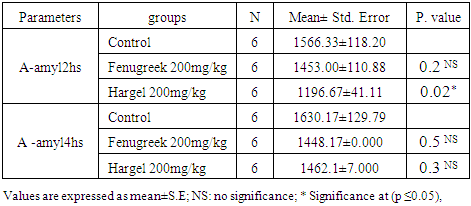 |
| |
|
Concerning the effect of (400mg/kg-b.w) of Trigonella foenum graecum (group 3), α-amylase concentration was (1371.6mg/dl and 1194.1 mg/dl) after 2 and 4 hours, there was no significant difference after 2 hours. While α- amylase concentration of group (6) which had been administered with (400mg/kg-b.w) Solenstomma Hargel aqueous extract after 2 and 4 hours was (2055.6mg/dl and 1999.1mg/dl), there was no significant difference with control group, (Table-8).Table (8). The effect of (400mg/kg-body weight) of Trigonella foenum graecum (Fenugreek) and Solenoslemma Hargel aqueous extract on α-amylase level of induced diabetic albino rats
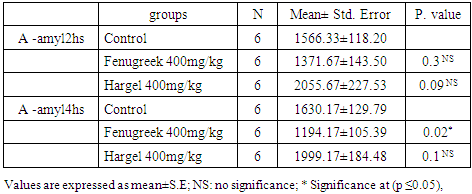 |
| |
|
Table (9) shows the effect of higher concentration (800mg/kg-body weight) Trigonella foenum graecum aqueous extract on group (5), α-amylase concentration was (1377.6mg/dl and 1568.3mg/dl) after 2 and 4 hours there was no significant difference with control group. On the other hand α-amylase concentration of group (7) which had been administered with (800mg/kg-b.w) of Solenstomma Hargel aqueous extract after 2 and 4hours was (2055.6 mg/dl and 1999.1mg/dl) there was no significant difference with control group.Table (9). The effect of (800mg/kg-body weight) of Trigonella foenum graecum (Fenugreek) and Solenoslemma Hargel aqueous extract on α-amylase level of induced diabetic albino rats
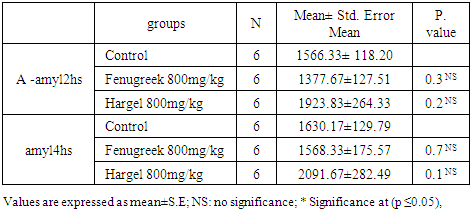 |
| |
|
4. Discussion
The current study was carried out to compare the biological effect of two Sudanese plants widely used traditionally for several medical purposes especially in the treatment of diabetes mellitus, these plants are Trigonella foenum graecum (Fenugreek) seeds, Solenoslemma Hargel leaves and bark. These plants are examined to investigate the hypoglycemic and anti-diabetic effects by detecting their effect on blood glucose, lipid profile and α-amylase enzyme.Results obtained from this study revealed that the aqueous extract of each plant had a hypoglycemic effect, (200mg/kg-b.w and 800mg/kg-b.w) of Trigonella foenum graecum (Fenugreek) seeds aqueous extract reduced blood glucose level to the normal level (P≤ 0.05), this agreed with [12] who pointed that in vitro and in vivo clinical studies have discovered the hypoglycemic action of fenugreek among the herbs for diabetes. Our findings also agreed with previous studies [19] who demonstrated that Trigonella foenum-graecum (Fenugreek) extract has a positive effects on blood glucose, blood lipid, and hem rheological parameters in experimental diabetic rats. The result of this study confirm previous study done by [1] which revealed that Trigonella foenum graecum (Fenugreek) is one of the plants that regulate glycolysis through its effect on blood glucose level. In present study, the effect of different concentrations (200, 400 and 800 mg/kg-b-w) of Trigonella foenum-graecum (Fenugreek) seeds aqueous extract on plasma lipids of diabetic albino rats were tested, the results agreed with [20] who represent that Fenugreek seeds decreased the level of serum triglycerides, total cholesterol and low-density lipoprotein. On the other part of the present study induced diabetic albino rats had been administered with three different concentration doses of Solenoslemma Hargel (200, 400 and 800mg/kg-b.w) the results indicated that the dose of (800mg/kg-b.w) Solenstomma Hargel extract had a hypoglycemic effect on blood glucose. Comparing the two plants. There was no significant difference, so their extracts reduced blood glucose to the normal level. Therapeutic approach for treating type 2 diabetes mellitus is to decrease prandial glucose levels as mentioned by [21] who tested Hargel extract on digestive carbohydrates Enzymes amylase and invertase in vitro , in this study the tested plants had α- amylase inhibitory activity with high dose (800mg/kg-b.w). this study agreed with previous researches [22] which proved that Hargel has steroids which may give its extract high potentially antifeedent agents on the other hand according to the research done by [1] who demonstrated that Trigonella foenum graecum Fenugreek had α-amylase inhibitory activity.
5. Conclusions
It could be concluded that the aqueous extract of the two tested plants used in this study have hypoglycemic effect. Moreover they have reducing effect on cholesterol and triglycerides level. Solenstomma Hargel had unexpected increase in α-amylase level at high concentrations of the extract (800mg/kg-b.w) compared to Trigonella foenum graecum which have a decreasing effect.
References
| [1] | Zimmet P, Alberti KGMM, and Show J. (2011) "Global and Societal implication of the diabetes epidemic" Nature; 414: 782-787. |
| [2] | Lozano R, Naghavi M, Foreman K, Lim S, Shibuya K, Aboyans V, et al. Global and regional mortality from 235 causes of death for 20 age groups in 1990 and 2010: a systematic analysis for the Global Burden of Disease Study 2010. Lancet. 2012; 380: 2095–128. doi: 10.1016/S0140-6736(12)61728-0). |
| [3] | Phyllis A. Balch, CNC and James F. Balch, M.D. (2000) Prescription for Nutritional Healing Third edition Pp9). |
| [4] | Fasanmade, OA; Odeniyi, IA, Ogbera, AO (2008). "Diabetic ketoacidosis: diagnosis and management". African journal of medicine and medical sciences 37 (2): 99–105. |
| [5] | Gloria Y. Yeh, MD, MPH, David M. Eisenberg, Roger B. Davis, ScD, and Russell S. Phillips (2002): Use of Complementary and Alternative Medicine among Persons with Diabetes Mellitus American Journal of Public Health, (92): 10. |
| [6] | Samia El-Sayed Saffan and 1 2Amani M.D. El-Mousallamy; (2008): (Allelopathic Effect of Acacia Raddiana Leaf Extract on the Phytochemical Contents of Germinated Lupinus termis Seeds) Journal of Applied Sciences Research, 4(3): 270-277. |
| [7] | Shapiro K, Gong WC (2002): Natural products used for diabetes. JAm Pharm Assoc 42: 217–226. |
| [8] | International meeting (1995) the development of guidelines for national policy on traditional medicine EMR drugs digest, 10(2): 3-12. |
| [9] | Laroubi A. Farouk L., Aboufatima R., Benharref A. , Bagri A. and Chait A. (2009) African Journal of Biochemistry Research Vol.3 (2), pp. 017-023. |
| [10] | Basch E, Uibricht C, Kuo G, Szapary P, Smith M (2003). Therapeutic Applications of Fenugreek. Alternative Med. Rev.8: 20-27. |
| [11] | Srinivasan K. (2005) Plant foods in the management of diabetes mellitus: spices as beneficial antidiabetic food adjuncts". Journal of Food Sciences and Nutrition 56 (6): 399-414. |
| [12] | Vijayakumar, et al (2005): the hypoglycemic activity of fenugreek seed extract is mediated through the stimulation of an insulin signaling pathway. Br J Pharmacol.; 146(1):41-48. |
| [13] | Murwan K. S. E. and Murwa A.M (2010): Chemical Composition, Minerals, Protein Fractionation, and Anti-nutrition factors in leaf of hargel plant (Solenostemma argel). |
| [14] | Kamel, M.S.,. Hassanin H.A. Mohamed M.H, Kassi R. and Yamasaki K., (2000). Monoterpene and pregnane glucosides from Solenostemma argel. Phytochemistry, 53: 937-940. |
| [15] | Harborne, J.B. (1984) phytochemical methods 2nd dition chapman and Hall. London and New York. |
| [16] | A.O.A.C. (1990). Association of Official Analytical Chemists. Official Methods of Analysis. 15th edition. Washington. |
| [17] | Konuklugil B., Denoz G., Yildi O., Senoz S. and Saygi S. (1997): Hypoglycemic effect Teucrium polium in rats. Fitoterapia LXV iii: (1) 39-41. |
| [18] | Snedecor, G.W. and WC. Cochran, (1989) Statistical Method, 8th end Iowa State University Press, Ames, Iowa. |
| [19] | Xue WL, Lie XS, Zhang J, Liu YH, Wang ZL, Zhang RJ., (2007) Effect of Trigonella foenum-graecum (fenugreek) extract on blood glucose, blood lipid and hemorheological properties in streptozotocin-induced diabetic rats. Asia Pac J Clin Nutr. 16(suppl1):422-426. |
| [20] | Samia J A, Asghar s, Fayaz. (2000) Relation of high-density lipoprotein cholesterol concentration type of diabetes and its control. Biomedica.; 16: 19-24. |
| [21] | Abdelrahman, S. H. (2011): Trypanocidal activity of some Sudanese medicinal plants against experimental Trypanosoma evansi infection. Research Journal of Medical plants. 5: 756-763. |
| [22] | Divya Jyoth and Marina Koland (2013): Design, Development and evaluation of antidiabetic liquid oral preparation from extract of fenugreek) international journal of Pharmaceutical research and bio-science. Volume 2(4): 39-47. |



 Abstract
Abstract Reference
Reference Full-Text PDF
Full-Text PDF Full-text HTML
Full-text HTML







